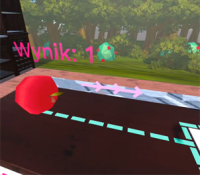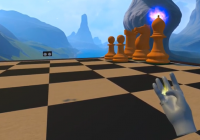Virtual Reality in Patient Rehabilitation
Scientists from the Faculty of Mechatronics of the Warsaw University of Technology have developed applications that use virtual reality to help treat people who have suffered a stroke.
The rehabilitation of stroke patients with unilateral neglect syndrome is a long and arduous process. The syndrome involves the lack of awareness of the existence of an affected side of the body, the absence of reaction to any stimuli on this side, and also upper limb paresis. The most common treatment exercise is a visual search both on the non-neglected and neglected sides to find an item and place it in an indicated location. Such rehabilitation, however, requires the full involvement of a physiotherapist, and patients quickly lose motivation.
A team from the Faculty of Mechatronics at the Warsaw University of Technology has created three applications which, through their use of virtual reality (VR), are intended to help in traditional rehabilitation or partially replace it.
– The games we developed enable the rehabilitation of people after a stroke. Two of them are intended primarily for patients with unilateral atrophy syndrome and paresis, and the third one is for people with hand paresis – says Katarzyna Matys-Popielska, the originator of the project.
A patient with unilateral atrophy syndrome cannot see half of the space around them. A typical exercise for this condition involves looking for objects (for example, bottle tops) on a table, grabbing them and placing them in a basket held by physiotherapists on the opposite, inactive side of the body.
– We have recreated this task in the virtual world in one of our applications. The patient moves the apple from the non-neglected side to the white box in the neglected area. Rehabilitation takes place without the active participation of a physiotherapist – after each properly performed movement, the apple reappears and the patient continues the exercise – explains Krzysztof Popielski.
The game designed for patients with hand paresis trains palpation skills. By performing specific hand gestures, identical to those in traditional rehabilitation, pieces are placed on a chessboard. The movement must be maintained for a certain period of time.
– Using virtual reality, we have created applications with repetitive exercises which have until now been provided by physiotherapists. Another advantage is the engaging, interesting exercise environment, which often results in longer rehabilitation time. In addition, sound elements, visible statistics, and animations increase the degree of patient involvement in the exercises – emphasizes Anna Sibilska-Mroziewicz, PhD, who is the project manager.
As part of the project, our scientists also check to what extent can these applications be used by people of different ages, and they compare the effectiveness of therapy with the use of VR goggles vis a vis conventional therapy. So far, the game has been tested by 25 patients aged 45-85 who are treated at the ORPEA Międzylesie rehabilitation clinic in Warsaw. The patients were very pleased about the possibility of rehabilitation with the use of virtual reality. They emphasized that it provides great variety, and this this encourages exercise. The fairy-tale surroundings and calming music were particularly appreciated. Studies have shown that people of all ages and those with various, often serious, diseases can handle VR games – a patient with quadriplegia managed to play a game designed for hand rehabilitation.
The project “A virtual reality game for the rehabilitation of people with paresis and neglect syndrome” runs from December 2022 to April 2024, overseen by a team from the Faculty of Mechatronics: Anna Sibilska-Mroziewicz, PhD, and PhD students: Katarzyna Matys-Popielska and Krzysztof Popielski. It was financed from the funds of the Institute of Micromechanics and Photonics at the Faculty of Mechatronics of the Warsaw University of Technology and the State Fund for the Rehabilitation of the Disabled (PFRON).










